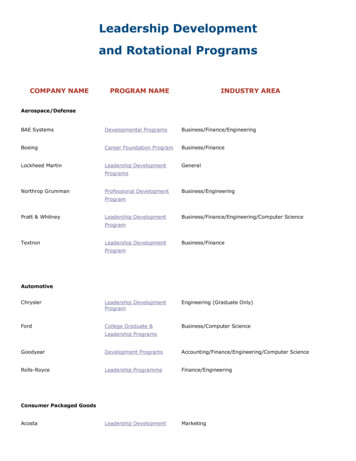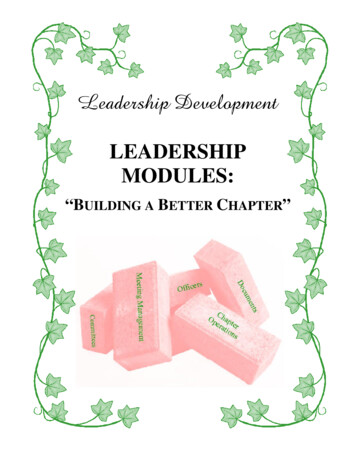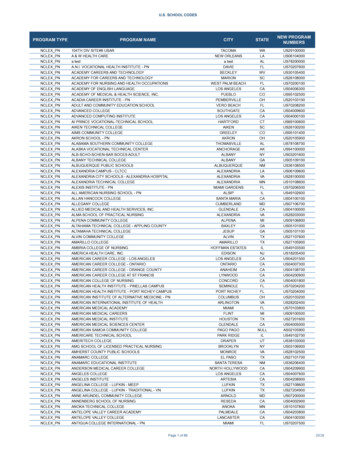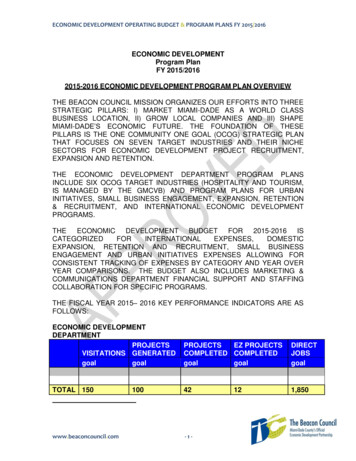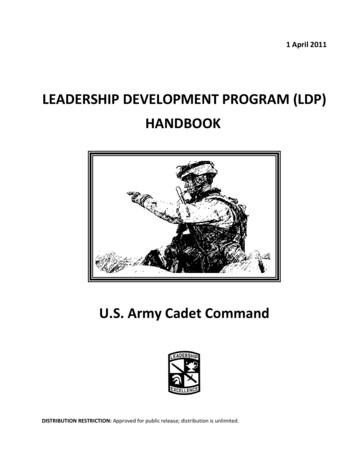
Transcription
1 April 2011LEADERSHIP DEVELOPMENT PROGRAM (LDP)HANDBOOKU.S. Army Cadet CommandDISTRIBUTION RESTRICTION: Approved for public release; distribution is unlimited.
Leadership Development Program (LDP) Handbook1 April 2011SUMMARY OF CHANGEThis version of the Leadership Development Program (LDP) Handbook replaces the previous version dated25 August 2009. While this update does not contain any significant changes in overall policies and/orprocedures concerning the execution of the Leadership Development Program, it does reflect alreadyadapted changes associated with revised forms in the Cadet Command Information Management System(CCIMS).The following is an overview of the changes and updates in this new handbook: Appendix B- Updates Developmental Counseling Form (DA Form 4856)Appendix C- Updates CAMPUS version of the Cadet Evaluation Report (Campus – CER) (CCF 67-9-C)- Updates LDAC version of the Cadet Evaluation Report (LDAC – CER) (CCF 67-9)Aligns discussion on CER development with instructions located in CC Cir 601-11-1.Introduces editorial changes throughout the document.
Leadership Development Program (LDP) Handbook1 April 2011Leadership Development Program (LDP) HandbookTABLE OF CONTENTSSUBJECTPAGEREFERENCES . 1PURPOSE . 1GENERAL . 1LEADERSHIP DEVELOPMENT PROGRAMPURPOSE . 1TRAINING FOR THE FUTURE . 2FEATURES OF LDP . 2LDP MODEL . 3ASSESSING BEHAVIORRECOGNIZING BEHAVIOR . 4RECORDING BEHAVIOR . 5CLASSIFYING BEHAVIOR . 6ARMY LEADERSHIP REQUIREMENTS MODEL . 6ATTRIBUTES . 7Leader of Character . . . 7Army VALUES . 7Leader with Presence . . . . 8Leader with Intellectual Capacity . . 8CORE LEADER COMPETENCIES . 9Leads . 9Develops . 9Achieves . 10RATING BEHAVIOR . 10LEADERSHIP ASSESSMENT/SPOT REPORT . 11CADET SELF-ASSESSMENT . 16PERFORMANCE FEEDBACK . 17After Action Review . 17Developmental Counseling . 18Peer Ratings . 19JOB PERFORMANCE SUMMARY CARD (JPSC)GENERAL .JPSC ADMINISTRATION .Cadet-Focused JPSC .Assessor-Focused JPSC .Appendix A – Leadership Performance Indicators .Appendix B – LDP Forms .Appendix C – Cadet Evaluation Report (CER) .Appendix D – Administering the LDPCadre Responsibilities .Cadet Responsibilities .Leadership Opportunities .Cadre Administration of the Leadership Development Program .20202022A-1B-1C-1D-1D-2D-3D-3Figure 1 – LDP Model . 3Figure 2 – Cycle of Assessment . 4Figure 3 – Army Leadership Requirements Model. 6Figure 4 – Sample Leadership Assessment Report (Front) . 12Figure 5 – Sample Leadership Assessment Report (Reverse) . 13Figure 6 – Sample Spot Report (Front). 14Figure 7 – Sample Spot Report (Reverse). 15Figure 8 – Sample Cadet Self Assessment Report (Front) . 16Figure 9 - Sample Cadet Self Assessment Report (Reverse, prior to counseling . 17Figure 10 – Sample Job Performance Summary Card (Cadet-focused). 21
Leadership Development Program (LDP) Handbook1 April 2011which make up the leader’s core are— Army Values. Empathy. Warrior Ethos.1. REFERENCES:a. AR 145-1, Senior Reserve Officers’ TrainingCorps Program: Organization, Administration, andTraining(2) BE: A Leader with Presence(What an Army Leader Is)Presence is not just a matter of the leader showingup; it involves the image that the leader projects.Presence is conveyed through actions, words, andthe manner in which leaders carry themselves. Areputation is conveyed by the respect that othersshow, how they refer to the leader, and respond tothe leader’s guidance. Presence is a critical attributethat leaders need to understand. A leader’seffectiveness is dramatically enhanced byunderstanding and developing the following areas: Military bearing: projecting a commandingpresence, a professional image of authority. Physical fitness: having sound health,strength, and endurance, which sustainemotional health and conceptual abilitiesunder prolonged stress. Composed and Confidence: projecting selfconfidence and certainty in the unit’s ability tosucceed in whatever it does; able todemonstrate composure and outward calmthrough steady control over emotion. Resilience: showing a tendency to recoverquickly from setbacks, shock, injuries,adversity, and stress while maintaining amission and organizational focus.b. Cadet Command Reg 145-3c. FM 6-22, Army Leadership2. PURPOSE: To establish procedural guidance forthe execution of the Leadership DevelopmentProgram within Cadet Command3. GENERAL: Leader development is a continuousprocess of training, assessment and feedback withthe goal of instilling and enhancing desirablebehavior in military organizational managers. WithinCadet Command, this process is known as theLeadership Development Program (LDP), modeledafter principles spelled out in FM 6-22, ArmyLeadership, and standardized in campus and LDACenvironments. The flexible methodology of LDPaccommodates personalized, individual developmentat all levels of proficiency throughout the cadet’sROTC experience, from program entry tocommissioning. The LDP includes basic leadershiptraining, periodic assessment, and counseling at bothteam and individual level by experienced observers.Trends and corrective actions are identified andfollowed with retraining and reassessment in acontinuous cycle. Effective leader development isprogressive, building on lessons learned andmaximizing individual potential.(3) KNOW: A Leader with Intellectual Capacity(What an Army Leader Is)An Army leader’s intelligence draws on the mentaltendencies and resources that shape conceptualabilities, which are applied to one’s duties andresponsibilities. Conceptual abilities enable soundjudgment before implementing concepts and plans.They help one think creatively and reasonanalytically, critically, ethically, and with culturalsensitivity to consider unintended as well as intendedconsequences. Some decisions may set off a chainof events. Therefore, leaders must attempt toanticipate the second- and third-order effects of theiractions. Even lower-level leaders’ actions may haveeffects well beyond what they expect. Theconceptual components affecting the Army leader’sintelligence include -- Mental agility Sound judgment Innovation Interpersonal tact Domain knowledge4. LEADERSHIP DEVELOPMENT PROGRAM(LDP).a. PURPOSE: The LDP is an individual-focusedtraining process designed to develop leadership skillsin a variety of training environments. It isadministered on-campus by a primary assessor(Military Science instructor) and at other courses(LTC, LDAC, etc.) by TACs (Train, Advise, Counsel),and uses an integrated system of structuredleadership opportunities to maximize potential andpredict success as a lieutenant. Periodically, cadetprogress is determined and individual potential tolead soldiers gauged. Using the Army’s BE-KNOWDO concept to express what attributes are required ofArmy leaders, the LDP seeks to develop cadets intoagile, multi-skilled officers who will:(1) BE: A Leader of Character(What an Army Leader Is)Character is essential to successful leadership. Itdetermines who people are and how they act. Ithelps determine right from wrong and choose what isright. The factors, internal and central to a leader,(4) DO: Core Leader Competencies(What an Army Leader Does)1
Leadership Development Program (LDP) Handbook1 April 2011The core leader competencies emphasize the roles,functions, and activities of what leaders do. Leadersserve to provide purpose, direction and motivation.LDP strives to develop Army leaders work hardto lead people, to develop themselves, theirsubordinates, and organizations, and toachieve mission accomplishment across thespectrum of conflicts.developmental feedback in the form of individualcounseling. Cadet performance is thoroughlydocumented in individual cadet files (e.g., JobPerformance Summary Cards and the CadetEvaluation Report) which reflect information used toquantify performance and potential. The assessmentof individual growth considers each cadet’s history ofperformance.Continuously building and refining values andattributes, as well as acquiring professionalknowledge, is only part of becoming a competentleader. Leadership succeeds when the leadereffectively acts and applies the core leadercompetencies and their subsets. As one moves fromdirect leadership positions to the organizational andstrategic leader levels, those competencies take ondifferent nuances and complexities.(3) Provides Developmental Feedback.Timely periodic performance feedback providescadets with tools to begin improvement. Each timecadet performance is assessed, notable strengthsand weaknesses are addressed and specific meansfor improvement are discussed in detail with thecadet. Depending on the nature of the assessmentscenario, the assessor provides formal or informalfeedback in the form of performance test scores,counseling sessions, coaching, encouraging andindividual or team after action reviews (AARs).b. TRAINING FOR THE FUTURE: Cadets train tomeet the need of the Army for leaders of characterwho can take charge under any condition. Properlyadministered, leader development provides cadetswith systematic problem-solving and self-analysisskills in a progressive cycle of training, periodicassessment, constructive counseling, retraining andreassessment. The counseling and other feedbackprocesses mirror those used in the US Army,familiarizing cadets with the expectations of theleader and enhancing their self-sufficiency and abilityto lead soldiers effectively. Analysis of each cadet’sgrowth or failure to grow provides valuable insight tothe cadet’s leadership potential. While timeconstraints do not normally allow cadets to be fullytrained during their time in the program, the skillsthey receive here enable continued development longafter they leave ROTC.(4) Structuring Leadership Opportunities.Leadership opportunities are practical exercises inleading and caring for subordinates, and used as atraining tool to emphasize key teaching points. Givensufficient time, cadets exhibiting random behavior willeventually demonstrate their abilities and potential;however, due to its unpredictability, random behaviorcannot be relied upon as a means of illustrating andemphasize teaching points in a timely manner. TheLDP utilizes formally structured leadershipopportunities by assigning cadets leadership roleswith specific and implied tasks and giving them timeto plan, prepare, and execute their duties. The use ofstructured opportunities enables assessors to directactions to ensure that experiences are consistentwith the cadet’s developmental needs.c. FEATURES OF LDP: The assessment processwithin LDP is standardized throughout the commandand is based on the following features:(5) Assessor Qualification. While unique toCadet Command, the LDP derives its basic elementsfrom Army leadership principles. Battalion cadrebring to ROTC a familiarity with those principles,along with a variety of technical, tactical, andleadership experiences. However, the greateremphasis placed on leader development in CadetCommand demands degrees of proficiency andstandardization among assessors beyond thoserequired in most Army experiences. Initial leadershipassessor training from the School of CadetCommand and subsequent on-the-job training (OJT)directed by battalion commanders complementsprevious experience. LDAC evaluation staffs provideappropriate orientation and assessment training tocadre assigned as TAC Officers/Non-CommissionedOfficers. LDAC training committee evaluators arealso trained in the assessment process, emphasizingspecific responsibilities for their particularcommittees, but based on standardized LDPassessment policies and principles.(1) Standardized Assessment Technology.Each LDAC and on-campus program assesses cadetbehavior using a prescribed process and commonleadership performance indicators (LPI) that arealigned with the attributes and core leadercompetencies in FM 6-22, Army Leadership(Appendix A). Each assessor must be trained in theapplications of LDP and faithfully model LDPskills/standards whenever possible. StandardizedCadet Command reports (Appendices B, C, & D) areused to document performance and potential.(2) Individual Focus. The LDP establishes amodel that identifies individual training needs, createsa plan of development, trains, and assesses cadetperformance, all with the goal of developing cadets totheir maximum individual potential. Following eachassessment, cadets are provided timely, focused2
Leadership Development Program (LDP) Handbook1 April 2011(6) Peer Ratings. Peer assessments utilizethe viewpoint of other cadets to provide additionaldevelopmental feedback to cadet leaders. Battalioncommanders and LDAC cadre employ peerassessments to assist in validating cadreassessments, identify trends and issues from withinthe cadet team, and provide valuable perspective onleader performance by those most affected. Becauseof their closer physical and social proximity, peers areoften the first to identify issues affecting leaderperformance.contracting, cadet promotions, overall LDACperformance, commissioning). In addition, thecomplete record of cadet performance/potential oncampus and at LDAC is fully documented on theCadet Evaluation Reports and entered into thecadet’s accessions packet.d. LDP MODEL: Leader Development begins onthe cadet’s entry into the ROTC program andcontinues until the cadet is commissioned as alieutenant. The focus shifts over time from basic lifeskills (interpersonal behavior, time management,physical appearance, etc.) to more complex,professional-level skills equal to those expected of alieutenant. Figure 1 reflects the command model foradministering the LDP.(7) Link to Evaluation and Accessions.Cadet performance at the Leader’s Training Course(LTC), Leader’s Development and AssessmentCourse (LDAC), and on campus is linked toevaluation and cadet management decisions (e.g.,Counseling1st SemesterMSL I & II Counseling2d Semester MSLCourseGrades(DA Form 4856)CampusBlueCard YellowCard JPSC DAForm4856CERMSL CourseGradesMSL IIIAccessionsPacketLDACMSL IVBlueCard YellowCard67-9-167-9-1A JPSC OER ScoredEvents CERMSLCourseGradesDevelopment PlanFigure 1 - LDP Model(1) MS I and MS II Years. The PMS ensuresall MS I and MS II cadets receive developmentalcounseling each semester from either an upper classcadet or a member of the battalion cadre. While thePMS may adjust this scheme to fit schoolcircumstances, the quality of all counseling iscontrolled, both in form and content, by battalion3
Leadership Development Program (LDP) Handbook1 April 2011cadre. This counseling is recorded on DA Form4856, Developmental Counseling Form (Appendix B).(2) MS III Year. From the standpoint oftraining, assessment, and leadership development,the MS III year is the most intensive of a cadet’sROTC experience. During this year, as the cadetprepares for and attends the Leader Developmentand Assessment Course (LDAC), performance andpotential data becomes a part of the permanentevaluation and cadet accessions record. The PMSmaintains a record of cadet performance during theMS III or MS IV year (whichever immediatelyprecedes LDAC attendance) and the data reflectedon the Cadet Evaluation Report (CER). Likewise, atLDAC, the Job Performance Summary Card (JPSC,Para. 6) and all scored events data is used todevelop the CER for each cadet. In both instancesthe cade
adapted changes associated with revised forms in the Cadet Command Information Management System (CCIMS). The following is an overview of the changes and updates in this new handbook: Appendix B - Updates

